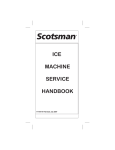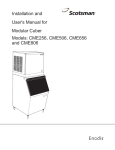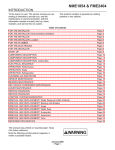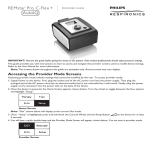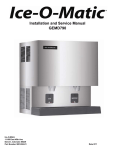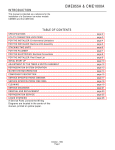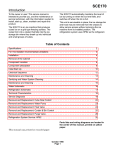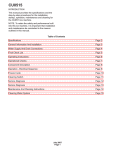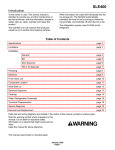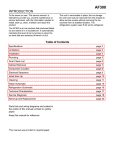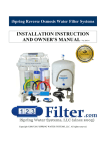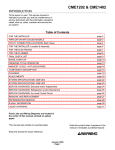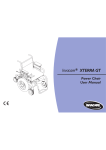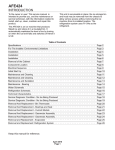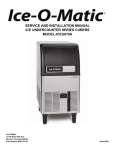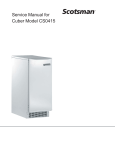Download SCE275 - Scotsman Ice Systems
Transcript
SCE275 Introduction To the owner or user: This service manual is intended to provide you, and the maintenance or service technician, with the information needed to install, start up, clean, maintain and repair this product. The SCE275 is an ice machine that produces cubed ice on a vertical freezing surface. The cubes fall into the ice storage bin where they break up into individual cubes. The SCE275 automatically maintains the level of ice by turning on when the ice level falls, and switches off when the bin is full. This unit is serviceable in place; the ice storage bin and hood may be removed from the chassis to allow service access without removing the ice machine from its installed position. The refrigeration system uses R-404A as the refrigerant. Table of Contents Specifications · · · · · · · · · · · · · · · · · · · · · · · · · · · · · · · · · · · · · · · · · · · 2 For The Installer: Environmental Limitations · · · · · · · · · · · · · · · · · · · · · · · · · · · 3 Installation · · · · · · · · · · · · · · · · · · · · · · · · · · · · · · · · · · · · · · · · · · · · · 4 Installation · · · · · · · · · · · · · · · · · · · · · · · · · · · · · · · · · · · · · · · · · · · · · 5 For The Plumber· · · · · · · · · · · · · · · · · · · · · · · · · · · · · · · · · · · · · · · · · · 6 Installation · · · · · · · · · · · · · · · · · · · · · · · · · · · · · · · · · · · · · · · · · · · · · 7 Removal of the Cabinet · · · · · · · · · · · · · · · · · · · · · · · · · · · · · · · · · · · · · · 8 Component Location · · · · · · · · · · · · · · · · · · · · · · · · · · · · · · · · · · · · · · · 9 Component Description · · · · · · · · · · · · · · · · · · · · · · · · · · · · · · · · · · · · · · 10 AutoIQ Controller · · · · · · · · · · · · · · · · · · · · · · · · · · · · · · · · · · · · · · · · · 11 Initial Start Up · · · · · · · · · · · · · · · · · · · · · · · · · · · · · · · · · · · · · · · · · · · 12 Notes On Operation · · · · · · · · · · · · · · · · · · · · · · · · · · · · · · · · · · · · · · · · 13 Adjustments · · · · · · · · · · · · · · · · · · · · · · · · · · · · · · · · · · · · · · · · · · · · 14 How To Operate The AutoIQ Controller · · · · · · · · · · · · · · · · · · · · · · · · · · · · · · 15 How The Electronic Cuber Works · · · · · · · · · · · · · · · · · · · · · · · · · · · · · · · · · 16 Water System · · · · · · · · · · · · · · · · · · · · · · · · · · · · · · · · · · · · · · · · · · · 17 Technicians Only: Freeze Cycle Operational Sequence · · · · · · · · · · · · · · · · · · · · · 18 Technicians Only: Harvest Cycle Operational Sequence · · · · · · · · · · · · · · · · · · · · · 19 Sanitizing and Water System Cleaning · · · · · · · · · · · · · · · · · · · · · · · · · · · · · · 20 Sanitizing and Cleaning · · · · · · · · · · · · · · · · · · · · · · · · · · · · · · · · · · · · · · 21 Additional Maintenance · · · · · · · · · · · · · · · · · · · · · · · · · · · · · · · · · · · · · · 22 Additional Maintenance · · · · · · · · · · · · · · · · · · · · · · · · · · · · · · · · · · · · · · 23 Additional Maintenance: Bin Controls · · · · · · · · · · · · · · · · · · · · · · · · · · · · · · · 24 Technical Characteristics · · · · · · · · · · · · · · · · · · · · · · · · · · · · · · · · · · · · · 25 Service Diagnosis · · · · · · · · · · · · · · · · · · · · · · · · · · · · · · · · · · · · · · · · · 26 Service Diagnosis · · · · · · · · · · · · · · · · · · · · · · · · · · · · · · · · · · · · · · · · · 27 Service Diagnosis · · · · · · · · · · · · · · · · · · · · · · · · · · · · · · · · · · · · · · · · · 28 PTCR · · · · · · · · · · · · · · · · · · · · · · · · · · · · · · · · · · · · · · · · · · · · · · · 29 Removal and Replacement: AutoIQ Controller · · · · · · · · · · · · · · · · · · · · · · · · · · 30 Removal and Replacement: Water Pump, Water Level Sensor · · · · · · · · · · · · · · · · · · 31 Removal and Replacement: Inlet Valve & Water Trough · · · · · · · · · · · · · · · · · · · · · 32 Removal and Replacement: Bin Control Set · · · · · · · · · · · · · · · · · · · · · · · · · · · 33 Removal and Replacement: Thermistors · · · · · · · · · · · · · · · · · · · · · · · · · · · · · 34 Water Distributors · · · · · · · · · · · · · · · · · · · · · · · · · · · · · · · · · · · · · · · · · 35 Refrigeration System Service: R-404A · · · · · · · · · · · · · · · · · · · · · · · · · · · · · · 36 Parts lists and wiring diagrams are located in This manual was printed on recycled paper. the center of this manual. January 2003 Page 1 SCE275 Specifications WATER REGULATOR 3/8-18 NPT (W/C ONLY) 4.00 IN. 10.16 CM. MINIMUM UTILITY CLEARANCE BACK VIEW POTABLE WATER INLET 3/8 FLARE 3.68 IN. 9.35 CM. 4.59 IN. 11.66 CM. 4.06 IN. 10.31 CM. 6.00 IN 15.2 CM. 3/4 FPT DRAIN 1.68 IN. 4.27 CM. ELECTRICAL CORD 7.17 IN. 18.21 CM. COND DRAIN 1/2-13 NPT (W/C ONLY) 9.12 IN. 23.16 CM. The unit is equipped with an electrical power cord, but should only be plugged into a circuit dedicated to the ice machine. 11.35 IN. 28.83 CM. THE NAMEPLATE IS LOCATED ON THE BACK PANEL A Serial Number Plate is Located on the Front Edge of the Base, Behind the Right Front Grill AutoIQ Controller (Behind Right Grill in A thru F Series) Controller Location in G Series and Higher Model Number Dimensions Basic (w/o) legs Electrical H" x W" x D" SCE275A-1G 33 x 30 14 x 30 115/60/1 Condenser Total Type Load Amps Air 15 Total Unit Wattage Refrigerant R-404A (HP62) 18 ounces SCE275A-32G 33 x 30¼ x 30 208-230/60/1 Air 8.4 18 ounces SCE275W-1G 33 x 30 14 x 30 115/60/1 Water 15 12 ounces SCE275A-6G 33 x 30 14 x 30 230/50/1 Air 7.5 1725 18 ounces SCE275W-6G 33 x 30 x 30 230/50/1 Water 7.5 1725 12 ounces 1 4 January 2003 Page 2 SCE275 For The Installer: Environmental Limitations The ice machine must be installed indoors in a controlled environment. Min Max Air Temp 0 50 F. 1000F. Water Temp 400F. 1000F. Water Pressure 20 PSI 80 PSI Voltage (60 Hz) 103.5 126.5 Voltage (50 Hz) 207 253 Air In Air Out Operating the ice machine outside of the above limitations, or outdoors, is potentially damaging to the machine, and it is misuse of the machine. This may void the warranty. Scotsman Ice Systems are designed and manufactured with the highest regard for safety and performance. They meet or exceed the standards of UL, NSF, and CUL Scotsman assumes no liability or responsibility of any kind for products manufactured by Scotsman that have been altered in any way, including the use of any part and/or other components not specifically approved by Scotsman. Airflow on air cooled models is: Intake through the left front grill. Exhaust through the right front grill. Do not install where this air flow is obstructed. The SCE275 has a removable cabinet. When installed, the machine should have some extra clearance ( 18") on the left and right sides so that the cabinet may be easily removed when the machine is in place. Scotsman reserves the right to make design changes and/or improvements at any time. Specifications and design are subject to change without notice. January 2003 Page 3 SCE275 Installation Water The water supply for this ice machine has been in contact with many materials since it fell from the sky as rain. All rain is slightly acidic, and tends to dissolve the materials it comes in contact with. During water’s journey to the ice machine, it has flowed over and through the ground, been picked up by a municipal or private pump, forced through a series of pipes of differing construction and may have been treated by the municipality providing the water. Electrical power is supplied through a cord connected to the unit. All local codes must be followed. This means that there is no such thing as “pure” water. All water contains some level of impurity. There are two ways water carries the impurities: suspended and dissolved. Water filters can remove the suspended solids, but cannot remove the dissolved portion. and electrical power supply. No extension cords are allowed. The building drain inlet must be lower than the drain outlet(s) at the back of the ice machine. The water supply must have a hand shut off valve accessible when the unit is installed. Cube ice machines use more water than is made into ice, the excess amount is used to dilute the concentration of minerals and “rinse” out the water system to keep the water scale from clogging up the machine. That water rinse, combined with water filters, prolongs the times between needed water system cleanings. 2. Determine the method of installation, is the machine to be installed under the counter? Is the drain in the floor under the machine? Is the water inlet valve accessible? The water to the ice machine should be filtered. Water filters vary greatly in ability and function. Install one that filters out suspended solids to a dimension of 5 microns or less. The finer the filter the better, but finer filters may plug-up sooner than course ones. It may be necessary to add a course filter ahead of the fine filter to prolong filter life. Pre-installation: 1. Inspect the place where the ice machine is to be installed. Check for: space for the cabinet, water supply, drain availability Unpack and Assemble 1. Remove legs and scoop from storage bin. 2. Remove shipping materials from ice making area. The SCE275 is factory set for a water purge that will work in most water conditions. While the amount of purge is adjustable, only change it if necessary. Note: Water use adjustments are customer convenience adjustments; they are not factory defects and are NOT covered by warranty. This ice machine may be installed in the open or under a counter. No clearance is required at the sides or top beyond what’s needed to place the cabinet into position. Air cooled models blow air in and out through the grills at the front. Space is required for utility connections at the back. The ice machine is not designed for outdoor use. It must be installed indoors, in a controlled environment. The air and water temperatures must not exceed rated limits. Remove Material Located Between Cube Deflector and Troughs 3. Place corner posts from the shipping carton on the floor behind the ice machine. Tip the ice machine on its back and remove the shipping skid. 4. Screw the legs into the threaded holes in the base of the ice machine. 5. Tip the ice machine back to an upright position. January 2003 Page 4 SCE275 Installation For The Plumber Begin by planning the installation and obtaining the needed supplies: 3 3 3 " soft copper tubing 8 " rigid drain tubing 4 " FPT fitting for bin/reservoir drain connection 4 " FPT fitting for condenser drain connection 1 2 " FPT fitting for water cooled condenser inlet connection 1. Connect cold potable water to the 3 8" male flare at the back of the cabinet. A water filter and hand shut off valve is recommended. Flush the water line prior to connecting to the ice machine. 3 8 If water cooled, connect a separate water inlet line to the water cooled condenser inlet fitting. It should also have a hand shut off valve. A loop of copper tubing may be used between the ice machine and the water supply. This will allow the ice machine to be pulled out from its installed location without disconnecting the water line. No back-flow preventer should be needed in the inlet potable water line because provision for that is incorporated in this N.S.F. listed product (the water valve outlet is above the reservoir wall and cannot siphon). 2. Connect a drain tube to each drain connection (water cooled drain must be separate). 3. Route the drain tubes to the building drain receptacle. CONFORM TO ALL LOCAL CODES Plumbing Connections, Water Cooled Shown Reservoir & Bin Drain Field Supplied Filter and Hand Valve Water Cooled Inlet Potable Water Inlet Water Cooled Drain Drain Receptacle January 2003 Page 5 SCE275 For The Plumber Drain Configuration: Water cooled models must use a separate drain tube from the reservoir/bin drain. The water cooled condenser drain should not be vented. Drain tube material must be rigid and meet local code. Traps in the bin drain line without vents ahead of them will cause poor draining. The bin drain must be vented if there is a long horizontal run (5’ or more). All drains are gravity, and must have a minimum fall of ¼" per foot of horizontal run. Maintain the air gap required by local code between the end of the drain tubes and the building drain receptacle. Note: Drain tubing should be insulated to prevent condensation from forming on the tubing. Vented Drain Potable Water Supply Air Cooled Plumbing Connections January 2003 Page 6 SCE275 Installation For The Electrician The 115 volt, 60 Hz model is a cord-connected unit, and must be on a separate 115 volt AC 60 cycle single phase power supply. The maximum fuse size for this circuit should be 15 amps. Per the nameplate use fuses, or HACR circuit breakers. Connect 50 Hz models to the correct voltage and fuses. Follow All Local Codes - This Unit Must Be Grounded. Do not use extension cords and do not disable or by-pass ground prong on electrical plug. After Utility Connections: 1. Level the cabinet, use the leg levelers on the end of the legs to adjust the cabinet height. (Legs should have been installed when the unit was unpacked). Check for levelness at the reservoir. 2. Wash out the bin and hood. If desired, the interior of the bin could be sanitized. 3. Locate the scoop, wash it and have it available for use when needed. Final Check List 1. Is the ice maker cabinet in a room where ambient temperatures are within the minimum and maximum temperatures specified? 2. Has the water supply been connected? 3. Is the water pressure adequate? 4. Have the water connections been checked for water leaks? 5. Have the drain connections been made? 6. Have the drain connections been checked for leaks? 7. Is the cabinet level? 10. Has the bin and cabinet been wiped clean and sanitized? 11. Has the Customer Evaluation & Warranty Registration form been filled out? Check for correct model and serial numbers from the nameplate, then mail the completed form to Scotsman. 12. Has the owner/user been given the name and telephone number of the authorized Scotsman Service Agency serving that location? 13. To start up machine, follow the directions on page 12. For more information on the unit, turn to the next page. 8. Is the ice machine plugged into an electrical power supply of the proper voltage and is the ice machine the only load on that circuit? 9. Has all of the shipping material been removed from the inside of the cabinet? Check for materials between the cube deflector and the water troughs (see page 4). Be sure the cube deflector is in place. January 2003 Page 7 SCE275 Removal of the Cabinet One of the most useful features of this ice machine is the ability to remove the cabinet from the ice machine without removing the ice machine from its installed position. 4. Pull the hood and door assembly straight out until it can be lifted up. STEP 4 Hood To Remove: To remove the cabinet base the hood must be removed first. 1. Remove 5 screws and the three grills at the front of the base. STEP 1 5. In the area behind the grills (removed in step 1) are two knobs similar to those removed in step 3. 2. Push and hold the Off button the AutoIQ Controller until the machine has switched OFF. Be certain the ice machine has been switched off. STEP 5 STEP 2 Unscrew and remove the two knobs. 6. Locate the bin drain. Loosen the hose clamp holding the drain tube to its fitting and pull the drain tube off of the fitting. Note: Controller on left side of cabinet on G series and higher. 7. Lift up the front of the base and rotate the base up and off of the ice machine. 3. Open the bin door and unscrew the knobs at the left and right inside of the ice storage bin. Unscrew the knobs all the way out. STEP 3 Bin Drain The machine is now exposed for service. January 2003 Page 8 SCE275 Component Location The ice machine is designed for front service. Many components are serviceable from the front without removing the cabinet. With the cabinet removed, nearly all components are serviceable. When the bin is removed, the condensing unit is visible. Water Distributors Evaporator Cover Reservoir Evaporators Water Trough Cube Deflector Compressor Refrigeration Access Valves Water Inlet Valve AutoIQ Controller, location shown for A thru F series Fan Motors Component Location These parts are located inside the bin: Evaporators Water Reservoir Water Pump Cube Deflector Water Troughs Water Distributors Controller Location, G series and higher Water Level Sensor January 2003 Page 9 SCE275 Component Description High Pressure Cut Out - Water Cooled Only Evaporators/Freezing Compartment: This is a switch that opens to stop the ice machine when the internal refrigeration pressures become too high (over 450 PSIG). It is an automatic reset. Location of the 2 evaporators. Ice forms on the evaporators and is released when warmed up during the harvest cycle. Evaporators Cube Deflector: Where the ice is formed. There are two vertical evaporator plates that form vertical strips of cubes. The strips break up into individual cubes as they fall. The slots in the inclined deflector let the water falling from the evaporators back into the reservoir, but when ice falls during harvest, the ice slides off into the bin. Thermostatic Expansion Valve Water Trough The thermostatic expansion valve is used to meter liquid refrigerant into the evaporator, adjusting the flow of refrigerant as required to make ice. Diverts water from the evaporators to the right and left to keep water off the ice. Reservoir: Only to be used by a certified technician. Allows access to the refrigeration system for diagnostic information. Contains the water used for ice. Water Inlet Valve: Refrigeration Service Access Valves: Opens to allow water into the reservoir. Water Pump: Water Level Sensor: Forces the water from the reservoir to the top of the evaporators. The motor is separated from the reservoir water to minimize contact with the water. Controls the size of the ice cube by measuring how much water is used in a cycle. It consists of a float, stem and electric eye. The stem will move slightly when the pump is on, this is normal. As the machine makes ice the reservoir water level will fall and the visible portion of the stem will slide down thru the slot in the sensor body. AutoIQ Controller: Controls the operation of the ice machine. Turns it on and off; switches it between cycles; shows information via indicator lights; and shuts the machine down if there is a problem. Compressor: The refrigerant vapor pump, it forces the refrigerant to flow thru the refrigeration system tubing. Hot Gas Valve: Closed during freeze, it opens during harvest to divert hot discharge refrigerant gas into the inlet of the evaporators. Condenser: Either air or water cooled, discharges the heat produced in ice making. January 2003 Page 10 SCE275 AutoIQ Controller Indicator Lights: Cycle Definitions: Bin Full: On when bin is full, goes on and off as ice falls during a harvest cycle. Freeze: On when the unit is in the Freeze cycle, blinks when a freeze mode is pending. Freeze: The refrigeration system is operating to remove heat from the evaporators. The compressor, fan motor (if air cooled) and water pump are ON. Harvest: The refrigeration and water systems are operating to harvest the ice cubes. While the compressor is on for the full cycle, the water pump will be off at the beginning and inlet water valve will switch off before the end. Harvest: On when the unit is in the Harvest cycle. Clean: On when the unit is in the Clean cycle, blinks when preparing for a clean mode. Off: On when the unit has been switched off, blinks when the machine is preparing to shut off. Water Error: On when the controller has identified a problem with the water system. Clean: The Inlet Water Valve opens to fill the reservoir. The Water Pump starts. The Clean indicator light is switched ON. A manually initiated rinse flushes the system. Refrigeration Error: On when the controller has identified a problem with the refrigeration system. 8 9 7 PUSH BUTTON CONTROL SWITCHES 6 5 INDICATOR LIGHTS: BIN FULL 4 FREEZE 3 HARVEST CLEAN 2 OFF ERROR LIGHTS: WATER 1 REFRIGERATION January 2003 Page 11 SCE275 Initial Start Up 1. Remove two screws and the left grill (G series and higher). 2. Locate the AutoIQ Controller - use a flashlight to see the buttons and lights. 3. Plug the machine in or switch on the electrical power. Note that the controller’s indicator lights all flash on briefly when power is connected. The freeze cycle will continue until the water level in the reservoir has fallen again to its factory set point, then the AutoIQ Controller may switch the air cooled fans off. After a short time, the Harvest Cycle will begin. Harvest Cycle: The Harvest indicator light will be ON, 4. Open the water supply valve to the machine. The hot gas valve will open. 5. Push and release the Freeze cycle push button (the Freeze indicator light will blink until the compressor starts). The next several operations are automatic. Initial Start (30 seconds) The water pump will stop. It will restart in less than a minute. The Freeze light begins to blink. The Hot Gas Solenoid valve will be open. The inlet water valve opens to fill the reservoir and shuts off when the reservoir is full. Note: If the reservoir does not fill the next steps do not happen. The water pump starts. Note: if the pump does not start the next steps do not happen. The inlet water valve opens again to refill the reservoir. After 30 seconds, the hot gas valve closes and the compressor starts. Freeze Cycle: The Freeze indicator light will come on. The machine will stay in a Freeze cycle for many minutes. Slush may appear in the reservoir, it is temporary and normal. Under certain conditions, the pump may stop for a few seconds. After that the inlet water valve will refill the reservoir. The fan motors (of air cooled models) will begin to turn and soon warm air will be forced out the front of the cabinet. After 4 minutes the fan motors may cycle on and off every 30 seconds in cooler ambients. As the freeze cycle progresses, the water level will fall and the inlet water valve will open to refill the reservoir. This will happen twice every cycle. The Inlet water valve will open. The machine will fill the reservoir and overflow it for a specified number of seconds then shut off. The harvest cycle may still be in progress. The Bin Full indicator light will go on and off as ice falls from the evaporators. 6. Machines are shipped from the factory with the purge level set to accommodate average water conditions. To achieve optimal machine performance, set the purge level to the minimum setting. Note: While the amount of water purge is adjustable, only those installations with a water supply known to be excellent (very low TDS or total dissolved solids) should adjust to the minimum setting. See page 14 for purge adjustment instructions. 7. Observe ice harvest. Check that the ice slides easily into the bin, and does not hang up on any mis-positioned part. 8. After about 5 minutes the machine will return to a freeze cycle. Note: The first 1-2 harvest cycles will be very long to establish a typical harvest time. 9. Fill out the Customer Evaluation and Warranty Registration. Send it to Scotsman. 10. Replace the front grill. 11. Inform the user of the location and telephone number of the local service company. Also inform the user of the required maintenance of the machine. August 2000 Page 12 SCE275 Notes On Operation 1. The electric eyes signal the ice machine to shut off whenever the bin becomes full. After the eyes sense that there is ice between them, the ice machine will shut off at the end of the next harvest cycle. This last harvest cycle will be longer than the rest, and will be for the Maximum Harvest Time. Note: Ice will normally fill up to the bottom of the evaporators before the machine shuts off. 2. After the bin has filled the ice machine will not be able to restart for 4 minutes. However, if needed, the Freeze button may be pushed and the unit will restart. For example: If ice is removed from the bin immediately after the machine has filled up and shut off, the machine will not restart for 4 minutes. 3. If the bin controls sense a bin full signal before any water is used (float stem up), the machine will shut off on bin full. If there was a problem during Initial Start Up: If an error light came on, check the following. 1. Water error. A water error could have been determined by the AutoIQ Controller if the inlet water valve does not fill the reservoir, or if the water pump does not start and lower the water level. 2. Refrigeration error. A refrigeration error could have been determined by the AutoIQ Controller if the water temperature did not drop during the freeze cycle. The controller will next check the compressor discharge temperature. If the discharge temperature is too low, the refrigerant error light will be switched on, and the machine will Shut Down. Resets: Note: The machine may be reset and restarted by pushing and releasing the Off push button switch, and then pushing and releasing the freeze push button switch. Water Cooled: If the water to the water cooled condenser circuit is cut off during a freeze cycle, the high pressure cut out will stop the operation of the compressor. The control is an automatic reset, but if the water interruption is prolonged, the AutoIQ Controller will shut the machine down when maximum freeze time has been exceeded. January 2003 Page 13 SCE275 Adjustments How to adjust the water cooled discharge pressure How to Adjust the Amount of Water Purge Water cooled models use a water regulating valve to control how much cooling water flows thru the water cooled condenser. At the top of that valve, located in the bottom rear of the ice machine, is an adjustment stem. Adjustment is done by use of the control buttons on the AutoIQ Controller. Examine the next section to become familiar with the AutoIQ Controller before beginning. To Adjust: 1. If the machine is on, push and hold the OFF button for more than 3 seconds, then release it. This switches the machine Off. 1. Attach a refrigeration manifold gage to the discharge access valve. 2. Push and hold the OFF button for more than 3 seconds (until all LEDs flash on) then release it. 2. While the unit is in the freeze cycle, determine the discharge pressure, it should be about 245 PSIG. 3. Examine the green LEDs. They should have all flashed once, then certain ones will have turned on to indicate which purge level the machine is set at. There are 5 levels of purge available: 3. If needed, rotate the adjustment stem to increase or decrease the pressure: A. To increase discharge pressure (reduce water flow) rotate the stem counter-clockwise. 1. Maximum Purge is when All 5 lights are ON. Note: This setting may extend the harvest cycle and reduce capacity. B. To decrease the discharge pressure (increase water flow) rotate the stem clockwise. 2. Heavy Purge is when these 4 lights are ON: Freeze, Harvest, Clean, Off . Remove the manifold when done. Note: The water outlet temperature should be between 100-110 when the valve is properly set. 3. Standard Purge (Factory setting) is when these 3 lights are ON: Harvest, Clean, Off . Thermostatic Expansion Valve: The TXV is not adjustable, do not attempt to adjust it. 4. Moderate Purge is when these 2 lights are ON: Clean, Off . 5. Minimum Purge is when this light is ON: Off . Adjust by pushing and releasing the Freeze button. Pushing and releasing the Freeze button increases the purge one level up to the maximum, then it goes to the minimum. 4. The machine will automatically restart after 60 seconds of no switch inputs, or restart the machine by pushing in and holding the Off button for more than 3 seconds, then releasing it. The unit will then be Off. From there the machine may be placed in a freeze cycle by pushing and releasing the Freeze button. January 2003 Page 14 SCE275 How To Operate The AutoIQ Controller The AutoIQ Controller is a microprocessor based device that receives input from several sources and switches various components on and off. Its manual control is thru the use of the Push Button Control Switches 1. Freeze Button. Pushing and releasing this button starts or restarts the machine. The AutoIQ Controller remembers what cycle it was last in and returns to that cycle. 2. Harvest Button: Pushing and releasing this button will cause the machine to go directly to a Harvest Cycle. Can be done from Freeze or Off. The machine will switch Off at the end of the Harvest cycle. 3. Clean Button: Pushing and releasing this button will cause the machine to only power the water pump for circulation of ice machine cleaner. After the ice machine cleaner has circulated for about 10 minutes, a second push of this button will switch on the rinsing system to flush out the dissolved scale and ice machine cleaner. LOW VOLTAGE IN/OUT 4. Off Button: Pushing and releasing this button will switch the machine OFF at the end of the next cycle. If the button is pushed and HELD for more than 3 seconds, the unit will switch off immediately. To Reset: First push and release the Off button, then push and release the Freeze button. WATER VALVE HOT GAS VALVE CONTACTOR COIL 8 STACKING 7 FUTURE USE 6 RESERVOIR & DISCHARGE LINE THERMISTORS 5 BIN CONTROL SENSOR 4 BIN CONTROL SENSOR 3 RESERVOIR WATER LEVEL SENSOR FACTORY USE 9 HI VOLTAGE IN/OUT WATER PUMP AIR COOLED FAN MOTOR PUSH BUTTON CONTROL SWITCHES INDICATOR LIGHTS: BIN FULL FREEZE HARVEST CLEAN 2 1 OFF ERROR LIGHTS: WATER REFRIGERATION January 2003 Page 15 SCE275 How The Electronic Cuber Works Controller Inputs: 1. Reservoir water temperature. This is measured by a thermistor located in the water pump outlet. 2. Discharge line temperature. This is measured by a thermistor located on the compressor discharge line. 3. Water level. This is measured by an infrared sensor and float. The float rises and falls with the water level, and switches the sensor on and off as it moves. 4. Bin fill level. This is determined by a set of electric eyes between the evaporators. Ice eventually fills the bin and covers the cube deflector to the point that ice is between the bin controls (and the evaporators); after 20 seconds of “blockage” the bin controls signal the controller that no more ice is needed. 5. Time. The controller measures and compares how long it takes for various events to happen. It stores that data for future reference. Controller Outputs: A. 24 volt: 1. LEDs 2. Inlet water valve 3. Hot Gas Valve 4. Contactor Coil B. High Voltage 1. Water Pump 2. Air cooled Fan Motor When ice is removed for use, the ice between the evaporators slides out into the bin and the ice machine automatically restarts. Note: A few cubes may remain on the cube deflector, this is normal. If little ice is used, the ice level will be high at the back of the bin. As ice is used, the ice will “level out” and fill the bin more evenly. When The Machines Fills Up To Its Shut Off Point, Ice Will Be On The Cube Deflector. January 2003 Page 16 SCE275 Water System Water flows into the ice machine during the harvest cycle thru the inlet water valve. The water valve will NOT be open the complete length of the harvest cycle. The water pump forces water to the top of the evaporators, both in the Freeze and Harvest cycles. Un-frozen water falls thru the cube deflector and back into the reservoir. As water is turned into ice, the water level in the reservoir falls to the full cube setting, and the Water Level Sensor sends a signal to the AutoIQ Controller to open Water Inlet the inlet water valve to refill the reservoir. This happens twice per freeze cycle. The third time the water level falls to the full cube setting it indicates to the AutoIQ Controller that it is time to begin the Harvest cycle. The air cooled fans will shut off just before the beginning of the Harvest cycle. Refrigeration System: The refrigeration system is similar to that of most commercial cube ice machines. Heat is removed from the water and discharged out the condenser during the freeze cycle. The evaporators are in series: As liquid refrigerant passes thru the Thermostatic Expansion Valve, it enters the bottom of the front evaporator, and ice will form there first. Refrigerant then flows out the top of the front evaporator and enters at the bottom of the back evaporator, finally flowing out the top row of the back Water Level evaporator Sensor Water Pump and back to the compressor. Evaporator During the Harvest cycle, water again enters the water reservoir, and overfills it to rinse the reservoir of accumulated minerals. It does NOT overflow for a fixed amount of time, but for a time determined by the AutoIQ Controller. The water Water Inlet pump will be Valve off for a short period of time at the beginning of harvest. Hot Gas Valve Thermostatic Expansion Valve When cubes need to be released (Harvest) the Hot Gas Bypass Valve is opened and hot discharge gas flows directly from the Reservoir compressor to the front evaporator Drain inlet. This warms up the evaporators and the surface of the ice frozen to the evaporator surface melts. Ice then falls into the bin. Filter/Dryer Compressor Fan Motor Condenser January 2003 Page 17 SCE275 Technicians Only: Freeze Cycle Operational Sequence How The Electronic Cuber Works This section is intended for the technician. It is not necessary for the normal operation and maintenance of the machine. The AutoIQ Controller operates the ice machine by monitoring several input measures and switching various loads on and off. Assuming the machine has been operational, the Freeze cycle begins with the end of the Harvest Cycle: Reservoir is full If the water level does “measure up" the water pump is restarted and the AutoIQ Controller then measures how long it takes to lower the water level. If the water level does not fall, the machine Shuts Down on a Water Error. 6. Once per cycle the machine may shut off the water pump. It only does this when the water temperature reaches a preset minimum. The pump will only be off for a few seconds. After the pump restarts, the inlet water valve opens to refill the reservoir. 7. When the water level falls to the pre-set limit, the inlet water valve will open to refill the reservoir. This happens 2 times every freeze cycle. Condenser fan is OFF Water Inlet Valve is OFF Water Pump is ON Compressor is ON Hot Gas Valve is ON AutoIQ Controller Operation, Beginning freeze: 1. Switches on the Freeze indicator light and shuts off the hot gas valve. 2. Measures and stores the discharge temperature. 3. Starts the fan motors (air cooled only). Fan control begins 4 minutes into the freeze cycle. When the discharge temperature indicates that cooler ambient conditions exist, the fan is cycled on and off every 30 seconds until it is switched of just before harvest. If the discharge temperature exceeds the design maximum, shuts the machine down on a Refrigeration Error. 4. Checks for a “bin full" signal throughout the cycle. 5. Measures the reservoir water temperature. If the machine is operating correctly, the reservoir water temperature will fall at a standard rate. The AutoIQ Controller will be checking to see if the water temperature fall matches that rate. If not, it re-checks the discharge line temperature. If too low, it Shuts Down on a Refrigeration Error. If the discharge temperature is acceptable, the water system is checked by shutting off the water pump and determining if the water level goes up enough. If it does not, it is assumed that there is a water pump problem and the machine Shuts Down on a Water Error. 8. As the machine makes ice, the water level in the reservoir will ultimately fall a third time to the Harvest Level (when the top electric eye in the water level sensor is disrupted by the adjustment screw). At that point, the fan may be shut off and the unit continues in a freeze cycle for a few more seconds (0-60 depending upon discharge temperature). Note: If the freeze cycle exceeds the preset Maximum of 35 minutes, the AutoIQ Controller will Shut Down on a Refrigeration Error. 9. The end of Freeze cycle will see the machine in this state: Water level = below harvest position Condenser fans will be off Water inlet valve will be off Water pump will be ON Compressor will be ON Hot gas valve will be off At this point Harvest begins and the AutoIQ Controller switches the Harvest indicator light ON. Note: If there is a power interruption, the AutoIQ Controller will automatically restart the machine with a process that begins with returning the machine back to a normal state: water re-fills the reservoir, the unit freezes for 30 seconds, and then goes thru a 4 minute harvest. After harvest it returns to a new Freeze cycle. While in this electrical restart mode, the controllers Freeze light will be blinking, even when it is in a Harvest cycle. January 2003 Page 18 SCE275 Technicians Only: Harvest Cycle Operational Sequence Harvest Diagnostic Lights: The (air cooled) fans are off. There are two diagnostic lights, one to indicate a water problem, and the other to indicate a refrigeration problem. If a Diagnostic Water Light Refrigeration Light: Light Blinks once and Water pump did Very long ice repeats not start harvest Blinks twice Lack of water No harvest of and repeats fill ice Blinks three not used High discharge times and temperature repeats Is On all the Water valve Check for low time leaking thru discharge rapidly temperature or long freeze cycle Both On all the Check for thermistor set time unplugged or failed The water valve opens and fills the reservoir to the Full level. The water pump shuts off, it will restart in less than a minute. The AutoIQ Controller checks how long it takes to fill the reservoir and if it was too much time, the machine Shuts Down on Water Error. Note: The machine will automatically attempt to restart after shutting down because of a lack of water. The time between restarts is about 20 minutes. The inlet water valve will stay on and open for a predetermined fraction of the time it took to fill the reservoir. This overflows and rinses the reservoir water. During the Harvest Cycle, ice will be falling from the evaporators and between the bin control’s electric eyes. The harvest cycle’s length is based on the actual time from the start of the prior harvest cycle until the last cube fell, plus an added amount of time as a margin. The maximum harvest cycle time allowed is 8 minutes. Harvest time is varied by the AutoIQ Controller based on the prior harvest cycle’s length. Restarts: The controller will attempt to restart the ice machine after the first and second shut downs because of a water or refrigeration error. There will be a 50 minute interval between restarts. If no cubes fall (or are sensed) by the end of Maximum Harvest Time, the controller senses a refrigeration error. If the next cycle also produces a refrigeration error, the machine Shuts Down. Note: The last Harvest cycle before shutting off on Bin Full will be longer than normal (4-5 minutes). During a harvest cycle, the water pump will shut off when the bin sensors indicate that the bin is full. There are two exceptions to this: 1. Lack of water. The controller will try to refill the reservoir about every 20 minutes after shutting down for lack of water. 2. Harvest errors: The controller must sense two consecutive harvest errors in order to stop the machine. The controller will try to operate the machine two additional times before a manual reset is needed. Note: The machine will not restart for 4 minutes after switching off on Bin Full, unless the freeze button is pressed. January 2003 Page 19 SCE275 Sanitizing and Water System Cleaning Cleaning Schedule: Air Filter (air cooled only): Scrub the door and frame edges once a week with soap and water. The air filter is located in a slot between the condenser fins and the condenser fans. Sanitize the bin interior once a month. 1. Remove the grill on the left front of the unit. Clean the water system and air cooled condenser a minimum of twice per year. If in an area of high mineral concentration in the water supply, clean water system 4 times a year. This ice machine will perform at its best when kept clean. There are three areas to keep clean: The water system including the water reservoir, distributors and evaporator surface; the bin controls; and the air cooled condenser filter and the condenser itself. Grill Screws Grill Removal Water cooled units: The water cooled condenser may, over time and under certain water conditions, become internally restricted by minerals. These will have to be dissolved by acid or the condenser replaced. Only a qualified service agent should attempt this type of service. 2. Locate the filter edge, it is between the condenser fins and the fan motors. 3. Pull the filter to the left though the slot in the front base of the ice machine. Air Filter Removal 4. Wash the surface of the filter off with cold water, or, if torn or so dirty it can’t be cleaned, replace with a new filter. 5. Return the filter to its installed position. 6. Replace the grill. Do not operate the unit without the filter in place. Note: If the unit has been operated without the filter in place, the fins of the condenser will become fouled with dirt, and must be cleaned. If there is any doubt about dirt inside the fins of the condenser, the cabinet should be removed and a qualified service agent should clean the condenser. January 2003 Page 20 SCE275 Sanitizing and Cleaning In Place Cleaning of the Ice Machine Water System: 1. Remove and discard all ice from the bin. If the cleaning was pre-planned, the ice machine could be switched off the night before to minimize waste. Note: A possible sanitizing solution may be made by mixing 1 ounce of liquid household bleach with 2 gallons of warm (95-115o F.) potable water. 2. Remove the left front grill. 10. Locate the two three-prong-head bolts holding the hood to the bin and remove them. 3. Push and release the Harvest button (this releases any ice that may be on the evaporators and warms them up). 4. Wait for the machine finish the Harvest cycle the machine will switch off). The Off light will be blinking. 5. Push and release the Clean button. The Clean indicator light will be blinking and the pump will re-start. 6. Pour 8 ounces (235 ml) of Scotsman Ice Machine Cleaner into the reservoir water (below the evaporators). 7. After the ice machine cleaner has circulated for 10 minutes, push and release the Clean button. Ice Machine Cleaner contains acids. These compounds may cause burns. 11. Remove the hood from the ice machine. 12. Locate the evaporator cover and remove the four thumb screws that hold it to the machine. Remove the evaporator cover. 13. With rubber gloves and a clean cloth or spray bottle, use the sanitizer solution to thoroughly wash or spray all interior surfaces of the ice storage bin, hood, knobs, and bin door with the sanitizing solution. Wash the joint between the hood and bin with the sanitizing solution. Also wash or spray the evaporator cover, the inside back wall of the freezing compartment, the top of the water distributors, the exterior surface of the reservoir, and the troughs with the sanitizing solution. 14. Return the evaporator cover to its original position and secure it with the original thumb screws. If swallowed, DO NOT induce vomiting. Give large amounts of water or milk. Call Physician immediately. In case of external contact, flush with water. 15. Return the hood to its normal position and secure it to the machine with the original bolts. 16. Pull cube deflector out of the reservoir. 17. Push and release the Clean button again. 18. Pour 11 ml or 2.25 teaspoons of liquid household bleach, or an amount of locally approved sanitizer of sufficient strength to create a sanitizing solution equal to 200 ppm of sodium hypochlorite in .75 gallons (2.8 l), into the reservoir water. KEEP OUT OF THE REACH OF CHILDREN. Pouring Ice Machine Cleaner into the Reservoir 19. Thoroughly immerse the cube deflector in a container of sanitizing solution. Cube Deflector This starts the rinse process. The Clean indicator light will be ON. Note: The rinse flushes any residual cleaner out of the ice machine’s water system. 8. Continue the rinsing process for 20 minutes, then push the off button to switch the machine off. Go thru steps 9-23 to sanitize the ice machine water system or go to step 24 to finish the cleaning process. 9. Mix 2 gallons of Sanitizer solution. Follow local codes for Sanitizer. 20. After the sanitizing solution has circulated for 10 minutes, push and release the Clean button. This starts the rinse process. 21. Continue the rinsing process for 20 minutes then push the off button to switch the machine off. 22. Repeat steps 10-15. 23. Return the cube deflector to its original position. 24. Push and release the Freeze button. 25. Return the front grills to their normal positions and secure to the machine with the original screws. November 2004 Page 21 SCE275 Additional Maintenance Water Distributors It may become necessary to remove the water distributors from the top of the evaporator and clean (de-mineralize) them outside of the ice machine. 1. Remove right front grill. 2. Push and release the OFF button. 3. Remove the machine’s hood & door. 4. Reach over the water distributors and pull the hose off. 5. Push the two water distributors to the right until the left end clears its retaining slot, then pull the left end up. Removal of Water Distributors 6. Repeat for the back one. 7. Examine the top of the evaporators. The Water Distribution Channels must be free from mineral build up. If build up is evident, scrub the channels with Scotsman Ice Machine Cleaner and a plastic bristle brush. To Remove Scale From Bin Interior: 8. Examine the water distributors. Although they are made of a material that is resistant to mineral build up, some may be present. Soak or scrub the distributors in or with a solution of Scotsman Ice Machine Cleaner and warm potable water. 2. Using rubber gloves, dip a nylon scouring pad into the cleaning solution and scrub the scale off the interior of the bin. 9. Return the water distributors to their normal installed position. To Drain Reservoir Completely (if desired): 9a. Snap the two distributors onto the water manifold. Place them on the back evaporator, right end first. Push the distributors far enough to the right until the left end clears the retaining slot, then release. Check that the distributors are seated properly. 2. Push and hold the Off button. 1. Mix a cleaning solution of 4 ounces of Ice Machine Cleaner to 4 pints of hot (950F.-1100F.) water. 3. After the scale has been removed, rinse all surfaces inside the bin with clean, potable water. 1. Remove front panel. 9b. Place the water hose onto the back water distributors. 3. Remove screw holding reservoir cover, pull inlet tube out of reservoir cover, lift cover out of machine. 4. Unplug water pump connection, remove ground screw. 5. Remove float from float stem. 9c. Repeat for the front evaporator. 6. Unplug water level sensor. 10. Reverse the above steps to reassemble. 7. Lift pump and sensor out of the machine. The storage bin must be cleaned regularly to maintain a sanitary environment. Once a week cleaning of the door and door frame with soap and water, a hot water rinse and an air dry is a basic procedure. Scale that may form on the plastic liner can be removed by scrubbing the surface with a mixture of Scotsman Ice Machine Cleaner and hot water. Remove any scale prior to cleaning. 8. Pull up on standpipe to release water. 9. Reverse steps 2-8 to reassemble. Note: Be certain that the float is fully re-seated on the stem and the water pump bracket is positioned properly on the base. Make sure that the stand pipe is properly seated. 10. Push and release Freeze button. 11. Replace front panel. January 2003 Page 22 SCE275 Additional Maintenance Exterior Cabinet Cleaning: To Check the Inlet Water Valve Screen. The exterior cabinet may be cleaned by scrubbing with soap and water. Do not use cleaners containing petroleum products. 1. Disconnect the electrical power. A nylon type brush may be used to scrub stubborn deposits. Additional Maintenance: Inlet Water Valve Screen The inlet water valve has a screen on its inlet side to keep debris from flowing into the valve. In some cases, this screen may become clogged or restricted by debris build up. Check for the proper water flow: 2. Shut off the water supply. 3. Remove the hood and bin. 4. Unplug the electrical connection of the inlet water valve. 5. Remove the screws holding the inlet water valve to the cabinet. Flow rate is 1.25 G.P.M. 1. Remove hood. 2. Remove right front grill. 3. Obtain a measuring cup and a watch. 4. Pull the water discharge tube out of the reservoir Inlet Water and place it in the cup. Valve 5. Push and release the Harvest button. 6. If working properly, the water valve will fill an 8 oz cup in about 3-4 seconds. Be prepared to push the Off button. If it does not, the water valve inlet or other water device is restricted. Removal of Inlet Water Valve 6. Remove outlet tube from inlet water valve. 7. Rotate inlet water valve from inlet fitting and remove valve from machine. 8. Examine the inlet screen, if dirty, brush off screen. Note: Screen is not replaceable, and may only be removed by taking off the covering bracket. The bracket forms part of the inlet water system, and must be water tight to the valve body, removal is not recommended. 9. Reverse to reassemble. January 2003 Page 23 SCE275 Additional Maintenance: Bin Controls The bin controls use a system of infrared emitting and receiving components to sense the build up of ice in the bin. They are located in between the evaporators. They must be free of mineral build up to function properly. To check: 1. Remove the right front grill. 7. Examine the bottom of the brackets, there are two sensors in each bracket, check that they are clear of mineral build up. They may be wiped clean with ice machine cleaner to assist in removal of the build up. Use a toothbrush if necessary to remove scale. 2. Push and hold the off button until the machine stops.. Be sure to drain the reservoir or go thru a Clean cycle to remove residual cleaner. 3. Remove the knobs holding the hood to the bin. Note: Do NOT use abrasive materials or cleaner on the bin sensor lenses. 4. Remove the hood.. 5. Remove the thumb screws holding the bin control brackets. Removal of Bin Controls Thumb Screw 6. Lift the the bin control brackets up and out from between the evaporators. Bin Controls, Clean Here January 2003 Page 24 SCE275 Technical Characteristics Air Cooled 70oF. air and 50oF. water Typical Freeze Cycle Time 15 minutes Typical Harvest Cycle Time 2 minutes Typical Low Side Pressure, end of 24 PSIG freeze Typical Discharge Pressure, end 235 PSIG of Freeze Typical Low Side Pressure, peak 130 PSIG in Harvest Typical Discharge pressure in 270 PSIG harvest 90oF. air and 70oF. water 18 minutes 1.5 minutes 29 PSIG Water Cooled 70oF. air and 50oF. water Typical Freeze Cycle Time 15 minutes Typical Harvest Cycle Time 2.5 minutes Typical Low Side Pressure, end of 24 PSIG freeze Typical Discharge Pressure, end 245 PSIG of Freeze Typical Low Side Pressure, peak 90 PSIG in Harvest Typical Discharge pressure in 175 PSIG harvest 90oF. air and 70oF. water 16 minutes 2 minutes 26 PSIG Typical Harvest Ice Weight 2.8 to 3.2 lb. Refrigerant Type / Charge R-404A / 18 ounces air cooled R-404A / 12 ounces water cooled. Hi Pressure Cut Out - Automatic Reset (water cooled only) 400 PSIG Cut Out + or - 10 PSIG 300 PSIG Cut In + or - 10 PSIG Typical Compressor Amp Draw Freeze: begins at 6.9 declines to 4.1 Harvest: 7 - 7.3 Superheat 4-6o F. 10 minutes into freeze cycle. TXV is not adjustable. Compressor Tecumseh hermetic, capacitor start, capacitor run (A series). January 2003 Page 25 306 PSIG 118 PSIG 240 PSIG 245 PSIG 93 PSIG 190 PSIG SCE275 Service Diagnosis Proper service diagnosis begins with observation, comparing the complaint to the operation of the unit. Ice machine service diagnosis should proceed from water, to electrical and then to refrigeration. Problem or Symptom Machine is off Unit is off on a Water Error Possible Cause Probable Correction Bin is full, ice in cube port Use some ice Power is off, check LEDs. If all lights are out, check power supply, restore power if off Transformer is open If all lights are out and there is power, check transformer output for 24 vac Unit has been switched off or has finished a Clean cycle, Off Light is glowing Push and release Freeze button Unit has Shut Down Check for Refrigeration or Water Error Water inlet valve malfunction Check water Light, if the Light blinks 2 times and repeats, check the water inlet valve for proper water flow.** Water pump malfunction Check that pump hose is attached and if pump is plugged in and working. Water level sensor may have failed. Check float stem, reset machine. If it will not reset or gives another water error and everything else is OK, replace the water level sensor. Low discharge or long freeze cycle Check refrigeration Light. If the Light is glowing, there is a probable refrigeration problem or on water cooled a water interruption Check refrigeration Light. If the Light blinks once and repeats, look for a harvest problem.** This also indicates that cubes were sensed by the bin controls. Harvest problem If the light blinks 2 times and repeats, check for a harvest error - no cubes sensed. Unit is off on a Refrigeration Error High Discharge Temp Check refrigeration Light. If the Light blinks 3 times and then repeats, check for a reason for high discharge temperatures - such as a bad fan motor or very hot ambient. Unit does not go into harvest - exceeds maximum freeze time Push and release Off button. Push and release Freeze button. Check operation. Unit runs and both Error Lights are ON Temperature sensors out of range Replace the temperature sensor set (water and discharge). Same, but 1 light is on Reservoir temp. wrong Check water temp and sensor. Push cube size float down and check operation. * Machine may be reset by pushing and releasing the Off button, then pushing and releasing the Freeze button. ** See following pages January 2003 Page 26 SCE275 Service Diagnosis Problem or Symptom Unit is off because of a “Harvest Problem” Cubes are too large Cubes are too small Possible Cause Probable Correction Bin controls did not sense ice falling, unit stayed in harvest until the maximum harvest time ran out. Push and release Off button. Push and release Freeze button. Check machine operation. Check if ice is made and harvests. Bin controls or AutoIQ Controller may have failed. See “Unit does not shut off” below.. Other components may have failed Check the next page Cube size control float is sticking. Check/clean Inlet water valve leaks thru Check inlet water valve Unit not level Check levelness Not enough water Check for leak in reservoir Dirty condenser or filter Replace filters, clean condenser Blockage of air flow Remove anything from in front of the machine that blocks the free flow of air. Low refrigerant charge Check system. If there is a low charge, find the leak, recover the refrigerant, repair the leak, replace the dryer, evacuate and weigh in the nameplate charge. Bin control system may have failed. Check bin controls. Check bin full light, if off, place something between the electric eyes. Note: Hood must be on. Use a piece of duct tape about 4" long and position it by hand between the evaporators. The bin full light should begin to blink (after 20 seconds of continuous blockage it will glow steadily). If not, check operation of electric eyes by unplugging #4 and jumping out the two pins on the controller. If the bin full light blinks, replace the bin controls. If it does not blink, replace the controller. Note: Leaving #4 unplugged and jumped for 20 seconds will shut the machine down on a bin full. It will restart after 5 minutes or may be reset by pushing the Freeze button. Low ice capacity Unit does not shut off Check bin controls. The bin full light should be off. If it is on or blinking the bin controls may be dirty. Clean if dirty. The board and bin controls may also need to be checked. January 2003 Page 27 SCE275 Service Diagnosis Problem or Symptom Possible Cause Probable Correction Open motor windings, or seized bearings, or blade stuck against shroud Replace fan motor or free fan blade. No power to fan motors Fan motor unplugged, check for voltage at controller. Controller cycles fan motors during freeze. If no voltage to the fan motors at controller during freeze, replace controller. Open motor windings, or seized bearings Replace pump No power to pump Check electrical connections. Check water level. Switch the unit to Clean, the pump should then have power to it. If not, replace the AutoIQ Controller. Open solenoid coil. Replace hot gas valve Stuck valve Replace hot gas valve No power to coil in Harvest Check wire connections, if ok, replace AutoIQ Controller Mechanical problem in valve Replace valve Open solenoid coil Replace valve Stuck valve Replace valve No power to valve (early part of harvest) Check wire connections, if ok, replace AutoIQ Controller Water Inlet Valve does not flow enough water Restriction in water supply Check water filters and/or inlet screen. Water Inlet Valve leaks thru Mechanical problem in valve Replace valve Unit in Clean cycle Push and release Freeze button. Contactor coil open Replace contactor Open starting components Check and replace Open windings Check and replace compressor Internal valve failure Replace compressor Fan motor(s) do not turn. Pump motor does not turn Hot Gas Valve does not open. Hot Gas Valve leaks thru (warm tube temperatures on both sides of valve during freeze) Water Inlet Valve does not open Compressor does not work January 2003 Page 28 SCE275 PTCR The “D” series and higher use a PTCR (Positive Temperature Coefficient Resistor) in place of a conventional start relay and start capacitor. Diagnosis: 1. Disconnect electrical power. 2. Check if the PTCR is cool enough to handle safely. Power from the contactor connects to the PTCR and If not, wait 5 minutes for it to cool off. to the Run Capacitor 3. Disconnect both leads to the PTCR and measure A wire connects the other terminal of the PTCR to its resistance with an ohmmeter. If the PTCR reads the compressor’s start winding. less than 22 ohms or more than 40 ohms, replace it. Another wire connects the run capacitor to the start winding. A parallel circuit connects power from the contactor to the Run winding of the compressor. A PTCR changes resistance sharply when its temperature changes. When the PTCR is cold, it connects full current to the compressor’s start winding. After a very short time, the PTCR heats up and shuts off the current flow. Under normal conditions, the PTCR’s case is at about 180oF. At that temperature the PTCR has very high resistance and will not allow current to flow. It must cool down to about 120oF. Before current will pas through it again. January 2003 Page 29 SCE275 Removal and Replacement: AutoIQ Controller Begin by disconnecting the electrical power. Electrical Box and Components Electrical shock hazard. Electrical shock can cause personal injury. Disconnect power before beginning to service 1. Remove 2 screws and the right front grill. 2. If the machine is operating, push and hold the Off button until the machine switches off. 3. Unplug or disconnect electrical power. 4. Remove the one screw at the right end of the AutoIQ Controller. 5. Pivot the controller up and away from its mounting bracket. Below the bin on the left side of the chassis is a sheet metal box containing the transformer, compressor contactor, compressor relay, start capacitor and run capacitor. This box may only be accessed by removing the hood and bin. After that: 1. Remove the cap screw securing the electrical box to the ice machine chassis. 2. Pull the electrical box forward to release it from the tab at the back of the box. 3. The box may now be placed in a horizontal position for better service access. Standpipe: The overflow standpipe is located at the back of the reservoir. The water pump and water level sensor must be removed to get access to it. 6. Unplug all connecting wires. The height of the standpipe is very important. Measured from the top edge of the reservoir to the very top of the standpipe, the distance should be: 7. Reverse steps 6-1 to replace the controller. 3 27 32" January 2003 Page 30 SCE275 Removal and Replacement: Water Pump, Water Level Sensor Water Pump Water Level Sensor The pump provides the force to move the water from the reservoir to the freezing surface. The pump does not need oil, but if it becomes noisy, overheats, or will not pump it should be replaced. Be certain to confirm electrical faults with a voltmeter or ohmmeter before replacing the pump. The pump should operate with the compressor. 1. Unplug or disconnect the electrical power. 2. Open the bin door and unscrew the knobs holding the hood to the bin. 3. Pull the hood off the bin. 4. Remove ground wire from mounting screw. 5. Unplug water pump. 6. Unplug water level sensor. Electrical shock hazard. Electrical shock can cause personal injury. Disconnect power before beginning to service components. 1. Unplug or disconnect the electrical power. 2. Open the bin door and unscrew the knobs holding the hood to the bin. 7. Remove the 2 screws holding the reservoir covers to the reservoir. 8. Pull the water pump and water level sensor assembly up and out of the reservoir. 10. Pull the float from the float stem. 11. From below the reservoir cover, push the mounting tabs together to release the water level sensor from the reservoir cover. 12. Reverse steps 11-1 to replace the water level sensor. 3. Pull the hood off the bin. 4. Remove ground wire from mounting screw. 5. Unplug water pump. Water Pump 6. Unplug water level sensor. 7. Remove the 2 screws holding the reservoir covers to the reservoir. 8. Pull the water pump and water level sensor assembly up and out of the reservoir. Water Level Sensor 9. Remove the screws holding the water pump to the two reservoir covers, and the pump is free to be replaced. 10. Reverse steps 9-1 to replace the pump. Mounting Plates January 2003 Page 31 SCE275 Removal and Replacement: Inlet Valve & Water Trough Water Inlet Valve The water inlet valve is located in the lower back of the cabinet. The hood and bin must be removed to gain access to this part. The valve is directly connected to the incoming water supply. With the water supply turned off, the connection can be removed from the front of the machine. Cover Removed From Utility Bracket 1. Go thru the steps on page to remove the hood and bin. 2. Locate the inlet water valve. Pull the wire harness off the terminals of the valve. 3. Remove the cover over the utility connections. 4. Use two wrenches and loosen the nut on the male flare holding the water supply to the water inlet connection. Remove the water supply line from the water inlet valve. 5. Remove the two screws that hold the water inlet valve to the cabinet. Inlet Water Valve 6. Pull the water inlet valve out and remove the discharge hose from the outlet of the valve. 7. The valve may now be removed from the ice machine. 8. Reverse steps 7-1 to replace the valve. Water Trough 1. See the next page and remove the bin controls first (steps 1-9). 2. Pull out the cube deflector. 3. Unsnap the trough from the evaporator pins and rotate the front trough out of the machine. 4. Unsnap the trough from the evaporator pins and rotate the back trough out of the machine. 5. Reverse to reassemble. Note: The troughs are marked: FRONT TROUGH and BACK TROUGH. Begin by hanging the troughs on the evaporator’s front pins and then rotating the trough until it snaps onto the back set of pins. Be certain that all 4 pins are engaged on each trough. January 2003 Page 32 View of Machine Without Bin or Hood SCE275 Removal and Replacement: Bin Control Set Bin Controls The bin controls are located in between the two evaporators, one on the left and one on the right. The hood must be removed to gain access to them. 8. Remove the thumb screws holding the bin controls to the evaporators. Bin Control 1. Remove the right front grill. 2. If the machine is making ice, push and release the Harvest button. 3. After the ice has fallen off the evaporators, push and hold the Off button until the machine stops. 4. Unplug the machine or disconnect the electrical power. 5. Remove the two knobs holding the hood to the bin. 6. Slide the bin forward to remove it from the ice machine. 7. Locate the bin controls and brackets. Bin Controls May Have a Shield Over Them Remove Mounting Bolt 9. Pull the bin controls up and out of the ice machine. 10. Trace the wires back to the connectors, and unplug them. 11. Reverse steps 10-1 to replace the bin controls. Flange of Bin Control Remove the Mounting Bolt First Edge of Water Trough Note: They MUST be changed as a set. The bin controls must be positioned so that the flange of the bin control is behind the water trough. January 2003 Page 33 SCE275 Removal and Replacement: Thermistors There is a thermistor to sense reservoir water temperature and another to sense compressor discharge temperatures. If the AutoIQ Controller senses a fault with the thermistors, both diagnostic indicator lights will be glowing continuously. Electrical shock hazard. Electrical shock can cause personal injury. Disconnect power before beginning to service 14. Insert the new thermistor into the discharge hose. Do not allow the body of the thermistor to contact the hose opposite of the mounting hole. 15. Secure thermistor with cable tie. 16. Plug thermistor into wire harness. 17. Return water pump and water level sensor to its normal position. Reconnect power and ground wires. 18. Return bin and hood to their normal positions. 19. Reconnect electrical power and push the Freeze button to restart the machine. 20. Return the grills to their normal position. Disconnect electrical power before beginning. 1. Remove the grills from the front of the cabinet. 2. Push and hold the Off button to shut the machine Off. 3. Remove the hood. 4. Remove the bin. 5. Locate the thermistor attached to the discharge line of the compressor. Remove the insulation covering the thermistor and un-clip it from the discharge line. 6. Unplug the thermistor from the wire harness by AutoIQ Controller. 7. Plug the new set into the AutoIQ Controller. 8. Route the thermistor to the discharge tube of the compressor and attach it to the discharge line in the same place as the original. 9. Re-cover the thermistor with insulation. 10. At the upper left of the machine, un-plug the water pump and water level sensor. 11. Lift up the water pump mounting plate and pull the water hose off the water pump. Remove the water pump and water level sensor and set aside. 12. Remove the water thermistor from the discharge hose of the water pump. 13. Unplug the thermistor from the wire harness. January 2003 Page 34 SCE275 Water Distributors Water Distributors are a snap-fit on the top edge of the evaporators. They are interchangeable left to right and front & back. Water Distributors When the water distributor’s have been removed, the top edge of the evaporator is exposed. That edge has small slots in it. Those slots must be clear of mineral scale build up to keep the water distribution even. Slots January 2003 Page 35 SCE275 Refrigeration System Service: R-404A This ice machine uses R-404A refrigerant and polyolester oil. Do NOT use mineral oil in this refrigeration system. Liquid Charging In preparation for charging, the low side hose should have a sight glass, and/or a restrictor device (such as R-404A is a “Near Azeotrope” so liquid charging a “Charge Faster”) installed in it for metering liquid into the low side of the system. is required: ¤ Weigh in as liquid as much of the charge as possible into the discharge line. ¤ Install a sight glass between the manifold and the suction side hose and carefully meter liquid into the suction side, using the manifold valve to “flash off” the liquid before it enters the ice machine. Do this until the proper amount of refrigerant has been weighed into the system. When the system is serviced, a special liquid line drier is required. It is included with replacement compressors. R-404A is not compatible with mineral oil, so these ice machines use Polyolester oil. Polyolester oil absorbs water very easily. When one of these refrigeration systems is opened for service, it must be re-sealed as soon as possible (15 minutes maximum). Special leak detection equipment is required to locate small refrigerant leaks. Usually a leak detector capable of detecting a Halongenated refrigerant or R-134a will work. Check with the leak detector manufacturer if in doubt. 1. After a thorough evacuation to at least 300 microns, shut off the manifold valves and switch off the vacuum pump. 2. Place a drum of R-404A onto an electronic scale. 3. Attach the charging hose to the drum. 4. Open the valve on the drum and purge the charging hose. 5. Zero out the scale. 6. Shut the low side access valve at the ice machine. 7. Open the discharge manifold valve full open. 8. Watch the scale, when the correct charge is shown, shut the manifold valve. Note: If all of the charge will not “go in” the discharge side: A. Shut the discharge access valve at the ice machine. B. Switch the machine on. C. Open the low side access valve at the ice machine. D. Open the low side manifold valve and observe the sight glass to be certain that only gas is flowing into the system. E. When the proper charge is indicated on the scale, shut off the manifold valve(s). Allen Wrench 9. Shut off the valve on the refrigerant drum. 10. Re-open the manifold valves until all liquid has flowed out of the hoses. Torque Stem to 6-8 ft. lb. Torque Stem Cap to 8-12 ft. lb. 11. Shut the low side access valve on the ice machine. Torque Core Cap to 7-12 ft. lb. 12. Remove hoses from ice machine and replace all caps. Access Valves Note: There are no valve cores in this valve. January 2003 Page 36




































